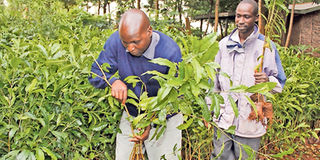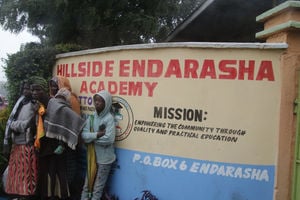Markhamia lutea, a versatile tree good for timber and medicine

Tree farmers check on seedlings in their nursery in Trans Nzoia County. The Markhamia lutea tree, which is also called muu (Kikuyu), siala (Luo), kyoo (Kamba), mungwani (Meru), mobet (Nandi), sogdu (Somali), ekokwait (Turkana), lusiola (Luhya), omwobo (Kisii) and mgambo in Swahili, is one of the most popular trees in Kenya, especially in the western region. FILE PHOTO | NATION MEDIA GROUP
What you need to know:
- The tree can be harvested for timber when it is 15-20 years old although they can live up to 30 years.
- The wood, which is resistant to termites, is especially suited for construction and fencing.
- Markhamia’s leaves, roots and bark are used in traditional medicine. Leaves and bark treat toothache, stomachaches, headaches, coughs and malaria.
- At Kefri, seeds cost Sh2,000 a kilogramme. Pre-sowing treatment is not necessary and under ideal conditions, seeds germinate in 20-30 days.
Markhamia lutea is a tropical African tree native to the continent’s lake basins and highlands in countries such as Ivory Coast, DR Congo, Ethiopia, Kenya, Tanzania and Uganda.
Its common English name is in honour of Sir Clements Markham (1830-1916), who introduced the quinine-yielding cinchona in India. The specific name, lutea, is Latin for golden-yellow, the colour of its flowers that are loved by bees for their nectar.
It is one of the most popular trees in Kenya, especially in the western region, where one of the uses of its wood is curing tobacco because of its odourless smoke.
A World Agroforestry Centre survey in western Kenya showed that it is the second most frequently planted tree species behind grevillea.
Its Kenyan names are muu (Kikuyu), siala (Luo), kyoo (Kamba), mungwani (Meru), mobet (Nandi), sogdu (Somali), ekokwait (Turkana), lusiola (Luhya) and omwobo (Kisii). In Kiswahili, it is called mgambo.
Markhamia grows in ecological zones of up to 2,000 metres above sea level and with annual rainfall ranging from 800mm to over 1,400mm, according to the Guide to Tree Planting in Kenya by Kenya Forestry Research Institute (Kefri). Although it is drought-resistant, it cannot withstand waterlogging.
The tree can be harvested for timber when it is 15-20 years old although they can live up to 30 years.
Markhamia ticks multiple boxes for end-use objectives for those planting it. It conserves soil and water, improves soil fertility and provides bee forage. In addition, it provides saleable products such as medicine, firewood, charcoal, fencing poles and timber.
Its timber is used in construction as beams externally as well as for internal finishings. It is suitable for flooring, interior trim, vehicle bodies, sporting goods, toys, boxes, crates and matches. It makes furniture, tool handles, walking sticks, boats and beehives.
The wood, which is resistant to termites, is especially suited for construction and fencing.
Another important benefit of this tree is soil conservation. Because of its big and fibrous roots, it works very well in erosion control and as a windbreaker on farms.
It is very leafy and hence provides mulch, which enhances soil-moisture retention and increases organic matter. For this reason, Markhamia lutea is often used as a shade tree in crops such as coffee.
REGULAR WEEDING
However, because of its multi-branches and fibrous nature of its roots, it can compete with crops such as bananas, maize and beans. The shade can be reduced through pruning and it is recommended to plant trees far apart when intercropping.
For those in apiculture, the tree has a number of advantages. Its bright yellow flowers provide good forage for honey bees. The sweet scent of its wood also attracts bees to hives made from it.
Markhamia’s leaves, roots and bark are used in traditional medicine. Leaves and bark treat toothache, stomachaches, headaches, coughs and malaria.
Roots are administered to children to treat convulsions and root and bark preparations are taken as a remedy against asthma, earaches, cough and gonorrhoea.
Ground leaves and bark are applied externally to treat skin complaints and wounds. Leaves are used for the treatment of snakebites and young shoots to treat throat complaints and diarrhoea.
In Uganda, where the tree is known as lusambya in Luganda, its roots are used in combination with other herbs to alleviate Aids symptoms.
Markhamia lutea can be used for control of the parasitic weed striga in cereal farming.
Young trees and seeds are vulnerable to attacks by boring beetles and rodents. It can also be attacked by shoot borers, which may result in crooked trunks.
The World Agroforestry Centre says measures such as overhead shading of saplings, mixed planting and removal of lateral shoots can reduce damage by shoot borers. There should also be regular weeding in the first year.
It is propagated by use of seedlings and wildings. At Kefri, seeds cost Sh2,000 a kilogramme. Pre-sowing treatment is not necessary and under ideal conditions, seeds germinate in 20-30 days.
To sow, broadcast the seeds thinly and evenly on a well-prepared seedbed (containing sand or a mixture of sand and soil). Then cover with a thin layer of sand/soil mixture and light mulch spread over the seedbed to keep it moist.
Watering should be done regularly (morning and evening) until they germinate. Mulch is removed immediately after germination starts. The young seedlings are transplanted when they are large enough to handle.




